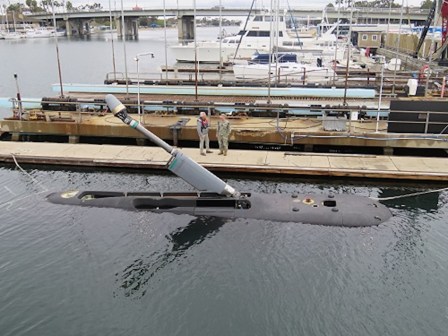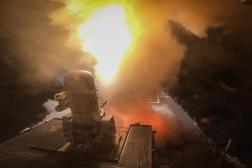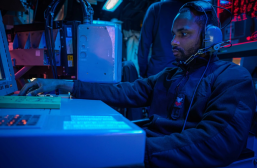Outgoing Navy CIO Aaron Weis: ‘We’ve elevated the role’

SAN DIEGO, Calif. — When Aaron Weis came into the Navy as its top IT official – following less than a year at the Pentagon and a career in commercial industry – he was surprised how far the service was behind in many technologic aspects.
Now, as he is set to depart his role as Department of Navy chief information officer next month, he believes that position has more clout, the Navy is well on its way to modernizing its IT systems and is now transitioning to a state of innovation.
“My initial impressions when I came in were that how far off the baseline the Navy was at a core infrastructure level … Coming in, as an industry CIO and seeing where we were at our level of capability is just not right,” Weis told DefenseScoop in an interview on the sidelines of the annual WEST conference in San Diego. “The CIO in an industry position is a fairly powerful role. The CIO of the Department of Navy, when I came in, was a fairly weak role.”
Weis said he’s worked to ensure the DON CIO office has been elevated, has more accountability and is able to get things done, being made a part of a Secretary of the Navy small group along with just four assistant secretaries and the general counsel.
Part of the elevation of the role is a recognition of the strategic importance of IT in the modern world, especially in the new paradigm of great power competition.
“This general awareness and acknowledgment that information technology is woven into almost everything we do in the modern world — there’s almost nothing that we could touch in the Navy or Marine Corps that doesn’t bump up against or fully use information technology at some level, from a tactical system all the way to the enterprise,” he said. “I think it’s an acknowledgment of that.”
The Navy has come a long way in the last four years he said, noting that modernization is real and has momentum, but acknowledged there is still more work to be done.
“There’s years of work left to do in modernization. But I think we’ve substantially moved the needle,” Weis said. “It’s got momentum, it’s got legs and it’s happened. That is gratifying to see versus early days where when we said we need to modernize because we’re behind. You get pushed back just by saying that. ‘What do you mean we’re behind? Why do you say that?’ I think there’s general awareness now.”
One of the successes he touted was the service’s move, along with others, to Microsoft Office365, rolling the productivity software suite out across the Navy and Marine Corps to nearly 700,000 accounts.
“I don’t care whether you’re government or industry, that’s a big lift to say I’m going to do that in a year,” he said. “We 100% did it.”
One area where the Navy still has work to do is in the cloud, especially under the paradigm Weis refers to as the cloud management office. Other examples of this construct within the military include the Air Force’s Platform One and the Army’s Enterprise Cloud Management Agency.
The Navy has been “late to the game” in this regard, Weis said, possibly attributing it to focusing on other areas over the years as well as the fragmentation of cloud the Navy, exemplified by the fact that at one point the Navy had the lowest total cloud spend among the services but the highest number of contractual vehicles.
“I have some frustration just on a personal level that we’ve not kept pace there,” Weis said, adding the Navy has learned a lot from watching the other services. “I’d like to think now that we’re focusing on that heavily, we need to get our strategic cloud management office in order and it’s happening. We’ve made some changes to the team structure to make that happen.”
Additionally, now that the Department of Defense awarded its enterprise cloud contract, the Joint Warfighting Cloud Capability (JWCC), the Navy has to figure out how to fit into that.
JWCC is a strong answer to procuring and provisioning for cloud, Weis said, acknowledging he’s 100% percent behind JWCC — but there needs to be a broader cloud management construct the Navy and Marine Corps own and manage, he said
While the department is not done with its modernization efforts, Weis explained the next phase involves innovation. This isn’t innovation for the next generation of technologies, necessarily, but more so “using what we have to solve problems for the warfighter or using what we have to put together solutions in an ingenious or entrepreneurial way. Oftentimes, it’s stuff we already own,” Weis said.
“Things we’re all doing or processes that we just need to think about differently and driving innovation to create capability,” he said. “That’s what we’re pivoting to now. Innovation is what’s going to give us a competitive advantage. Competitive advantage is how we win.”
One of Weis’ big pushes in the last year or so has also been changing the paradigm for the Navy when it comes to cybersecurity — shifting from a culture of compliance to one of readiness, building out lines of effort associated with becoming “cyber ready” and staffing it with personnel to drive the transition.
“I believe from a Department of Navy perspective, we’re doing it wrong. We treat this as a compliance problem,” he said. “We’ve got this long track record of failure in that area that says it’s not a compliance problem. I’ve made the assertion that this is more akin to how the military views the problem of readiness.”
The notion is that compliance is merely checking boxes attesting to certain goals that are typically static for a period of time as opposed to readiness, which occurs on a continuum.
“When we think about readiness, we think about more than just ticking the box. We think about the people, the workforce, the training, equipment, supply chain, it’s a very holistic way to view the problem and it’s an acknowledgment in the world of readiness that it’s a dynamic state, you live in a state of being, a state of readiness and it changes. You exist on a continuum,” Weis said. “That’s a much better analogy, in my opinion, for how to approach the problem of cybersecurity.”






